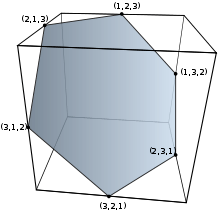Skewb
The Skewb (/ˈskjuːb/) is a combination puzzle and a mechanical puzzle in the style of Rubik's Cube. It was invented by Jac Bossman and marketed by Uwe Mèffert. Although it is cubical in shape, it differs from Rubik's construction in that its axes of rotation pass through the corners of the cube rather than the centres of the faces. There are ten such axes, one for each space diagonal of the cube. As a result, it is a deep-cut puzzle in which each twist affects all three faces.


Mèffert's original name for this puzzle was the Pyraminx Cube, to emphasize that it was part of a series including his first tetrahedral puzzle, the Pyraminx. The catchier name Skewb was coined by Douglas Hofstadter in his Metamagical Themas column, and Mèffert liked it enough not only to market the Pyraminx Cube under this name but also to name some of his other puzzles after it, such as the Skewb Diamond.[1]
Higher order Skewbs, named Master Skewb and Elite Skewb, have also been made.[2][3]
Piece orientation
Although the Skewb looks simple, its pieces are actually divided into subgroups and have restrictions that are apparent upon examining the puzzle's mechanism. The 8 corners are split into two groups—the four corners attached to the central 4-armed spider and the four "floating" corners that can be removed from the mechanism easily. These corners cannot be interchanged i.e. in a single group of four corners, their relative positions are unchanged. They can be distinguished by applying pressure on the corner—if it squishes down a bit, it's a floating corner. The centers only have two possible orientations—this becomes apparent by either scrambling a Skewb-alike puzzle where the center orientation is visible (such as the Skewb Diamond or Skewb Ultimate), or by disassembling the puzzle.
Records
The world record time for a Skewb is 0.93 seconds, set by Andrew Huang of Australia on 12 July 2019 at WCA World Championship 2019 in Melbourne, Australia.[4]
The world record average of 5 (excluding fastest and slowest) is 2.03 seconds, set by Łukasz Burliga of Poland on 17 December 2017 at CFL Santa Claus Cube Race 2017 in Bełchatów, Poland, with the times of 2.48 1.91 1.71 1.39, and 4.98 seconds.[4]
Top 7 solvers by single solve[5]
| Name | Fastest solve | Competition |
|---|---|---|
| Andrew Huang | 0.93s | WCA World Championship 2019 |
| Leo Min-Bedford | 0.97s | Selangor Cube Open 2019 |
| Daniel Vædele Egdal | 1.04s | Tårnby Cube Træf 2019 |
| Jonatan Kłosko | 1.10s | ŚLS Wodzisław Śląski 2015 |
| Riley Norrid | 1.11s | Cubalaya 2019 |
| Zongyang Li (李宗阳) | 1.11s | Shijiazhuang Open 2018 |
| Łukasz Burliga | 1.11s | Project Będzin 2019 |
Top 5 solvers by average of 5 solves[6]
| Name | Fastest average | Competition |
|---|---|---|
| Łukasz Burliga | 2.03s | CFL Santa Claus Cube Race 2017 |
| Michał Rzewuski | 2.13s | III Masovian Open 2019 |
| Michał Krasowski | 2.23s | LLS VI 2018 |
| Rasmus Stub Detlefsen | 2.28s | WCA Euro 2018 |
| Léo Bailly | 2.35s | WCA Euro 2018 |
See also
- Dino Cube
- Dogic
- Megaminx
- Pocket Cube
- Professor's Cube
- Pyraminx Diamond
- Pyraminx Duo
- Pyraminx
- Rubik's Revenge
- V-Cube 6
- V-Cube 7
- V-Cube 8
References
External links
- Birgit Nietsch's Skewb page
- Jaap's Skewb page
- Kirjava-Meep Skewb Method proposed by Thom Barlow and Kristopher De Asis.
- Sarah Strong's Skewb Method with variations for all skill levels.
- Rubik'skewb solution by Hideki Niina.
- Ranzha's Skewb Method by Brandon Harnish.
